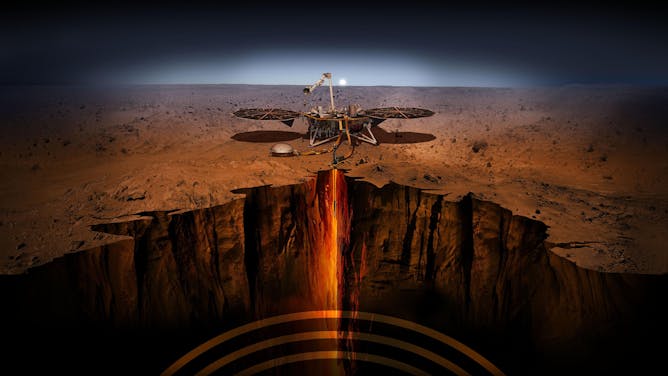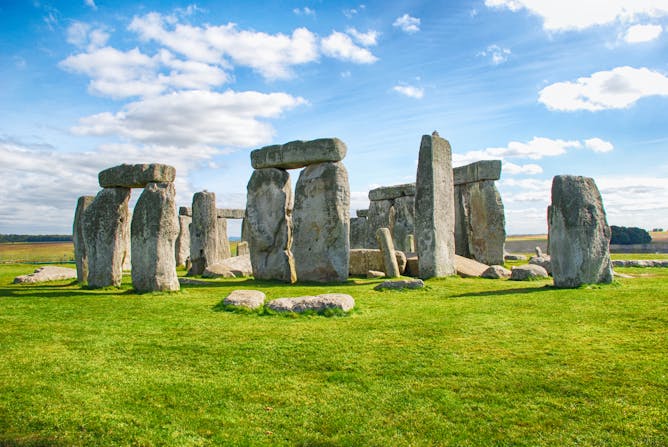|
|
|
|
Landing on Mars is incredibly hard, with fewer than half of missions succeeding. On Thursday evening, Nasa’s Perseverance rover will face the dreaded “seven minutes of terror” as it makes its way down to the surface of the red planet. The spacecraft will have to decelerate from more than 30 times the speed of sound to stationary, while it’s heated to 1,300°C by friction with the upper atmosphere. The delay in signal transmission means it
will have to do this autonomously, without being steered from Earth.
The landing isn’t just crucial for the mission itself. Some 3,000km from the landing site, another Nasa probe – Mars InSight – will “listen” to the landing. Designed for seismic exploration, InSight’s job is to detect “marsquakes”. While it has successfully detected several such events, scientists have been unable to work out their details, such as how large they were or where they occurred. That’s because they have no known seismic event to
compare with. Luckily, the landing of Perseverance could provide just that – a point of reference. We know exactly where the rover will land, how much it weighs and what its landing velocity will be.
Back on Earth, the UK government has now given 15 million of the people most vulnerable to COVID-19 at least once dose of vaccine, but it needs to think carefully about who should be prioritised next. And we hear from some of the researchers who made a fascinating series of discoveries to confirm that parts of Stonehenge first stood 140 miles away in Wales.
|
Miriam Frankel
Science Editor
|

|
|

Artist impression of Mars Insight.
NASA/JPL-Caltech
Benjamin Fernando, University of Oxford
The Perseverance rover's landing could help reveal secrets of Mars' interior.
|

Neil Hall/EPA-EFE
Vageesh Jain, UCL; Paula Lorgelly, UCL
For now, the UK will continue with its age-based prioritisation, but there's a case for key workers and the socially disadvantaged to start feeding into the vaccine queue.
|

Mr Nai/Shutterstock
Mike Parker Pearson, UCL
A remarkable set of discoveries has confirmed that parts of Stonehenge first stood 140 miles away at Waun Mawn, west Wales.
|
Science + Technology
|
-
Andrew Coates, UCL
Scientists preparing to land the Rosalind Franklin rover in a few years are nervously awaiting the landing of Nasa's Perseverance rover.
-
Neil Greenberg, King's College London
Professor of Defence Mental Health, King's College London
-
Tony Prescott, University of Sheffield
Robots and humans can be friends – but not in a way that would win Aristotle's approval.
|
|
Politics + Society
|
-
Toby James, University of East Anglia
Significant steps need to be taken for elections to go ahead safely in May.
-
Eliga Gould, University of New Hampshire
In the early 19th century, the British – who had invented impeachment centuries before – decided it no longer served its purpose. Instead, they found a more effective way to handle a bad leader.
-
Camilo Tamayo Gomez, Birmingham City University
Despite a landmark deal in 2016 which brought an end to five decades of conflict, an upsurge in mass killings is threatening peace in Colombia.
|
|
Environment + Energy
|
-
Sankar Sivarajah, University of Bradford
UK still ships huge amounts of plastic waste to places like Vietnam, Malaysia and Pakistan.
-
Mark Titley, Durham University; Stephen Willis, Durham University
Nearly 700 species of flightless mammal could be barred entry to cooler habitats due to national borders by 2070.
|
|
Health + Medicine
|
-
Amanda Ellison, Durham University
When headaches strike, many people reach for a painkiller. Probing the reasons behind the pain is often a better idea.
|
|
Education
|
-
Martin Myers, University of Nottingham
Persistent educational inequalities are a feature of schools, too – and schools and homeschooling operate in close relation to each other.
|
|
Business + Economy
|
-
Anica Zeyen, Royal Holloway; Stephanos Anastasiadis, Police Academy of Lower Saxony
People who feel their work is a calling have more resilience against the negative effects of overwork and stress, but this comes at a cost.
|
|
Arts + Culture
|
-
Heather McLaughlin, Concordia University; Bonnie Harnden, Concordia University
Do we need to just endure grumpy pandemic walks? Play therapists offer tips about how to light up the important family and community connections and routines in your life.
|
|
| |
Featured events
|

|
Online Oxford Martin School Event, Online, Oxfordshire, N/A, United Kingdom of Great Britain and Northern Ireland — University of Oxford
|

|
Online, Online, Oxfordshire, N/A, United Kingdom of Great Britain and Northern Ireland — University of Oxford
|

|
East Road, Cambridge, Cambridgeshire, CB11PT, United Kingdom of Great Britain and Northern Ireland — Anglia Ruskin University
|

|
Sustainable Places Research Institute, Cardiff University, Cardiff, Cardiff [Caerdydd GB-CRD], CF10 3BA, United Kingdom of Great Britain and Northern Ireland — Cardiff University
|
|
|
|
| |
| |
| |
| |
| |
|
|
|
|
|
|
|